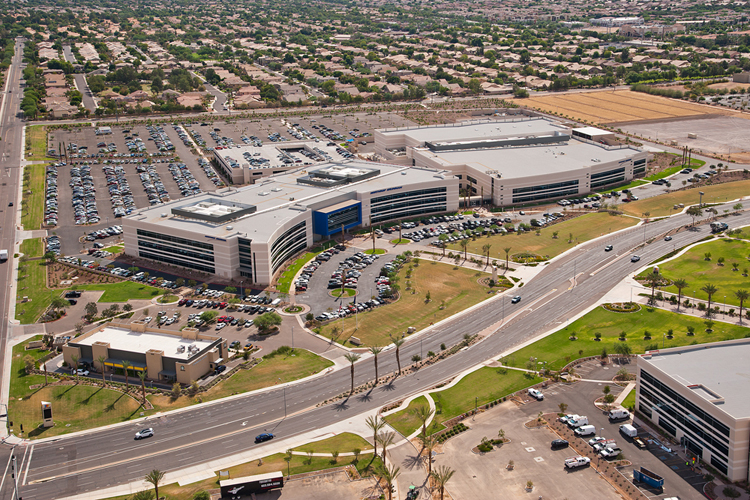Consistency may be boring, but when it comes to the commercial real estate outlook and the Greater Phoenix commercial real estate industry, no change is good for business.
“At this point in the market and cycle, Phoenix, literally, has everything,” said Roland Murphy, director of research at ABI Multifamily. “We’re still highly affordable, have massive success in economic development across a range of job levels/industries, and are consistently modernizing and adapting our quality of life for the better.”
The United States is in what most economic experts feel are the latter stages of a growth cycle that is stretching into its 11th year. Many are signaling a global economic slowdown and are warning that could trigger the start of a recession in the U.S.
However, commercial real estate experts in the Greater Phoenix market still see significant room for growth in all of the market sectors. The strongest sectors heading into the next decade are the multifamily and industrial markets, as the influx of people coming to Arizona is expected to continue and the demand for logistics, manufacturing and distribution space will remain strong.
Industrial outlook
It looks like full steam ahead in 2020 for the industrial market. Deliveries and vacancies were steady heading into 2020 and asking rents were trending upward, so all signs point to a healthy marketplace for industrial products.
“We are a very healthy and active market,” said Steve Larsen, executive vice president at JLL. “People are optimistic about the current state of the industry and what appears to be a lot of runway ahead. I expect we’ll see more manufacturing and logistics requirements landing here, which will continue to keep us well balanced.”
The industrial market appears well balanced, with healthy activity in submarkets across the Valley.
“I’m most optimistic about tech-related advanced manufacturing space, particularly around the Chandler and (Phoenix-Mesa) Gateway airports,” said Pat Harlan, executive vice president at JLL. “We are seeing solid pre-leasing activity in both of these submarkets, and both have a finite amount of available land.
“Right now the Southeast Valley has about 2.3 million square feet under construction, which is right where it should be when you look at the vacancy rate of 6.9 percent and the 2 million square feet absorbed in the area through the third quarter of 2019.”
“There is great vibrancy in the Loop 303/I-10 submarket and the Loop 202/East Chandler submarkets,” added Isy Sonabend, senior vice president at NAI Horizon. “Both industrial markets are in strong build cycles while attracting a myriad of Fortune 500 companies with state-of-the-art construction. The West Valley submarkets are building with an eye towards e-commerce and manufacturing … big box warehouses and plants.”
Another product type that the Valley should expect to see more of is data centers. Microsoft has purchased land in the West Valley with plans or data center campuses, and in the East Valley, the Elliot Road Technology Corridor in Mesa has attracted Google.
The majority of new industrial growth in the Valley will come in the form of distribution and logistics centers to cater to the growing e-commerce market. While those will be large-scale products, there is also ample activity heading into 2020 for small and mid-size industrial tenants.
“Everyone is hearing about the major data centers and e-commerce continues to be strong, as well as advanced manufacturing,” said Will Strong, executive managing director, Cushman & Wakefield.. “There is a good balance, as the bid sheets for our investment sale offerings continue to be full and our leasing partners continue to lease space.”
Multifamily outlook
Solid economic fundamentals? Check.
Huge influx of new residents? Check.
Growing demand for rental housing? Check.
The Greater Phoenix market checks all of the boxes that indicate a very healthy environment for multifamily owners, operators and developers. The strong momentum and the fact that the market is woefully short on supply makes Phoenix one of the top markets for multifamily investors for the next few years.
“These strong fundamentals, coupled with meager levels of overall housing supply (single-family and multifamily), are pushing vacancy rates to historically low levels which should keep Phoenix among the top rent growth markets nationally in 2020,” said Matt Pesch, executive vice president with CBRE Phoenix Multifamily Institutional Properties division. “Phoenix is still one of the most affordable major markets in the Western United States.”
New multifamily projects are being planned all over the Valley, but more is needed. According to Tom Brophy, the director of research at Colliers International in Arizona, there is a 20,000 to 30,000 unit deficit in multifamily based on the population growth Maricopa County is experiencing.
“Our vacancy rates are the lowest they’ve been since the 1970s,” said Chris Roach, associate vice president, Colliers International in Arizona. “Some of the headwinds for developers have been rising construction costs and a shortage of skilled labor.”
But those headwinds are no match for the shifting demographics and desires of people moving into the Valley.
“We are living through a tectonic shift pushing us further and further into a more renter-centric society which started in earnest in 2011 and 2012,” according to Cindy Cooke, senior executive vice president at Colliers International in Arizona. “Renter household levels have increased nearly 7 percent since 2000. More locally, Maricopa County has witnessed a stunning 20-plus percent increase.”
The rising number of residents in Maricopa County and their choice to rent instead of purchase has created a housing shortfall, something that the Phoenix market may not be able to remedy.
“By our estimation, metro Phoenix is building 10,000 to 15,000 too few housing units annually,” said Asher Gunter, executive vice president with CBRE Phoenix Multifamily Institutional Properties division. “Because of the current labor shortage, it’s not likely that developers will be able to build fast enough to keep up.”
One potential area for investors to cash in on the high demand for multifamily products is in the value-add market. In the Phoenix market, the average multifamily development with 100 or more units was built in 1994, making the vast majority of those properties ripe for improvement. While key markets such as Central and Midtown Phoenix, Tempe and Scottsdale have already been targeted by investors in value-add properties, there are ample other areas that could see investor activity in the next few years.
“Glendale has fantastic opportunity in value add, as do the more mature portions of Chandler and South Phoenix,” said Murphy. “Investors have to be better-informed and selective than they did a couple years ago, but the opportunity is still there for careful shoppers.”
Office outlook
The Greater Phoenix office market is following a similar trajectory as the industrial and multifamily markets. The outlook for 2020 and beyond is strong based on a large influx of companies moving into the market. Those companies are either escaping higher operational costs in coastal markets or expanding into the market, making the demand for office space high.
“New buyers coming in aren’t afraid of high watermark pricing; they are looking for a flag in Phoenix and are looking for alternatives to pricing in West Coast gateway markets like San Francisco, Seattle and Los Angeles,” according to Newmark Knight Frank’s executive managing directors Michael Garlick and CJ Osbrink. “Particularly in Tempe, Scottsdale and the Camelback Corridor, which are driving highest rents and have the most aggressive buyer pools.”
The numbers leading into the final quarter of 2019 were unprecedented, with record absorption (over 3 million square feet through Q3), record construction numbers and a healthy amount of pre-leasing activity by coworking companies. Since 2010, the market has seen the vacancy rate drop 40 percent, from 19.7 percent in 2010 to the current record low rate of 11.7 percent.
“Phoenix is extremely well-positioned to continue seeing corporate expansions and relocations,” said Steven Schwartz, managing director of ViaWest Group. “This is due to a pro-business environment that includes a low cost of doing business, low cost of living, proximity to California (without actually being in California), excellent quality of life, and our universities pumping out qualified graduates in critical fields.
“We have had record office absorption in the last few years and it is coming in all sizes and in diversified industries, including financial services, healthcare and technology. This is really the first growth cycle that we have had such a degree of industry diversity.”
Coworking giant WeWork is already leasing a large amount of space at two office developments that will begin filling up in 2020, Block 23 at CityScape and The Watermark. Other major office projects expected to be delivered in 2020 are Wexford (227,000 SF), I.D.E.A. Tempe Phase I (185,833 SF), 777 Tower at Novus Innovation Corridor (169,500 SF) and Rio2100 Phase V (169,000 SF).
All of these products are hoping to attract large tenants to quickly fill this new, Class A space.
“If absorption velocity continues, and all indicators are that it will, it is going to get more and more difficult for smaller tenants to find space,” said Laurel Lewis, senior vice president for NAI Horizon. “Lease rates are still on an upward trajectory and lease ready space is less abundant. Tenants will need to start looking for space earlier than they have in the past several years. Competition for lease ready space is heating up.”
Retail outlook
One market sector that could see a slowdown is the retail sector, due to shifting consumer habits. In Greater Phoenix, the retail industry is healthy, with an overall vacancy rate at 6.9 percent, which equals pre-recession levels.
“The residential growth, infrastructure, education and employment will drive the retail market in 2020,” said Rommie Mojahed, director of retail leasing and sales for SVN | Desert Commercial Advisors. “However, I am concerned with the rising construction costs and record high lease rates, but we are still much cheaper than California.”
Scott Glenn, national retail director for Marcus & Millichap, said that the Phoenix retail market is viewed as a primary market as far as national investors are concerned, something that hasn’t always been the case.
“Anytime you have population increasing, job growth, household formations; these are all good for retail,” Glenn said. “And, there hasn’t been a whole lot of brand new construction since the last big cycle, so that has helped keep vacancy rates down.”
There is retail construction occurring in the suburbs and developers continue to bring new products to where the new housing developments are. In the more established parts of the Valley, there will likely be very little new construction as many big box stores have closed.
“There is very limited new shopping center development due to so many big-box tenants that are retooling themselves to be more competitive in the digital economy,” said Dave Cheatham, president of Velocity Retail Group. “I think in 2020 that the amount of new development will go down at least 30 percent. This will bring about a slowdown of new store development and cause the decline in ground-up construction.”
Cheatham said that the most active market category will be smaller buildings (under 10,000 square feet) with single-tenant occupants or multi-tenants.
Both Cheatham and Mojahed believe that the arrival of the new Fry’s Food Store in Downtown Phoenix will help boost the retail prospects in the Central Business District.
“Roosevelt Row is a great example of restaurants and entertainment, and more is on the way,” said Mojahed.
“Every new residential project that creates a larger, 24-hour population base drives demand for more retail,” added Cheatham. “This is a healthy and positive transition to the Phoenix downtown market, as Phoenix matures and catches up with other major metro areas.”
One ongoing retail issue that will likely remain unsolved for at least a few years is what to do with former iconic malls like Fiesta Mall in Mesa and Metrocenter Mall. These formerly robust retail centers have outlived their usefulness as shopping malls, but with the right redevelopment, could become valuable community assets once again.
“I believe there will be education and office or employment opportunities,” Mojahed said. “Both sites offer freeway access and an abundance of parking that accommodate these types of uses.”
“(Redevelopment) can be complicated as multiple ownerships exist in many of the major tenants which can hamstring a mall owner,” said Cheatham. “The Covenants, Codes and Restrictions often inhibit the transformation of these projects into today’s real estate requirements, even though the real estate is well located.”
Land outlook
Land values will continue to rise as the Valley spreads ever wider. In the central business districts in the Valley, vacant lots are very scarce, as developers are cashing in on these infill development opportunities. One area that will likely see a sharp rise in land values is the area surrounding the new South Mountain Loop 202 freeway, which will be up and running in 2020.
“I think this freeway will be a tremendous tool to connect the East Valley to the West Valley,” said Kuldip Verma, founder and president of Vermaland. “I think we will really start to see this area grow and develop. I predict many new projects coming to that area.”
Vermaland owns a huge portfolio of land, primarily in the far West Valley, and he is confident that his investment in that part of the Valley will pay off. He cites all of the growth in Buckeye, which was the fastest-growing city in the United States from July of 2017 to July of 2018. Also, some of the world’s most successful companies like Google and Amazon are buying up land in the West Valley, and even Bill Gates and a group he is a part of has acquired 30,000 acres of land for development.
“I see a lot of the growth to come to Phoenix headed west,” Verma said. “It is one of the only areas where land prices are still relatively low. Certain parts of the West Valley are only a couple hours from parts of California.”
Another area that could be ripe for development is Pinal County. Nikola Motors and Lucid Motors have begun work on their manufacturing facilities in Pinal County and those are predicted to bring in more than 5,000 jobs. Add in the expected arrival of support companies to these two automobile plants, and the number of new jobs could tick over 10,000. Developers have long taken a wait-and-see approach to buying up land in Pinal County, but now that work is starting on these major employment drivers, 2020 could see a rash of land transactions in that submarket.




